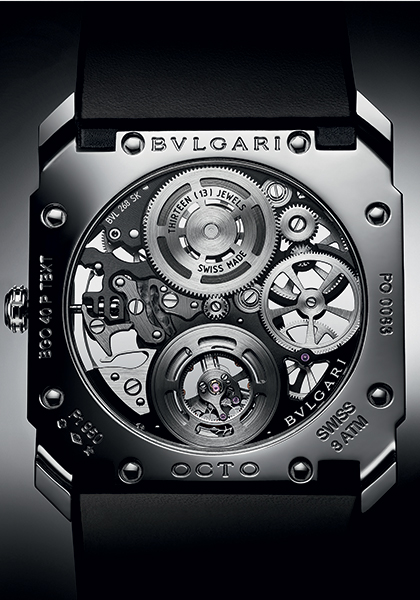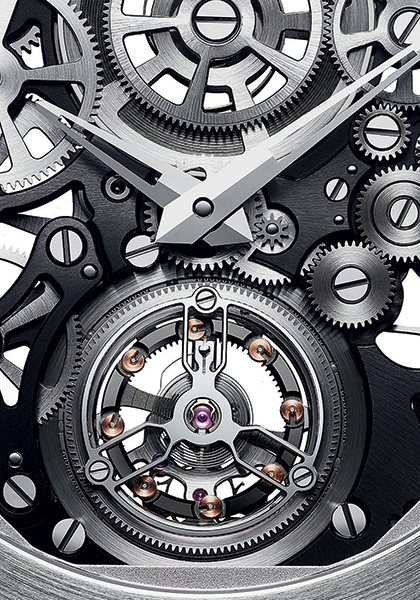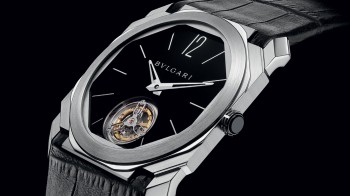The first in a long series of record-setting pieces, the Octo Finissimo Tourbillon took first place on the podium well ahead of the competition. The Bulgari Manufacture de Haute Horlogerie in Le Sentier discovered a whole new realm of application and innovation: a flying cage, flying barrel, semi-flying gear train – and a thickness of just 5 millimetres.
In 2014, Bulgari embarked on a new product strategy, building on the success of the fourth-generation Octo line and consisting in a subcollection: Octo Finissimo. Its vocation was to revisit each watchmaking complication in turn, establishing new records in slimness. Since the tourbillon occupies a central position in both watchmaking technique and watch-lovers’ imaginations, the Haute Horlogerie manufacturing facility based in the Vallée de Joux began by producing the Octo Finissimo Tourbillon. The case is made from platinum, but with a satin finish; the dial features an extremely deep, intense black lacquer finish, with applied hour-markers incorporated into the lacquer layer. It also boasts the hallmark aperture at 6 o’clock, showcasing the tourbillon cage with its three openwork arms and a brass-coloured balance (a shade later altered to match the grey tones of the calibre).

Combination
The watch’s calibre, the BVL268, is just 1.98mm thick, thus enabling the case to be no thicker than 5mm. The combination of the 40mm diameter and the curved lugs ensures the piece sits snugly on the wrist, and avoids the saucer-like appearance of certain ultra-slim watches, so flat that they are not very becoming atop the curve of the arm. The record-setting nature of the piece also needs to be put in its context. In terms of pure thickness, this piece measured up against the best of its kind at the time, particularly since the best at the time were in a close battle in keeping their watches under the 7mm mark… the difference coming down to just a few hundredths of a millimeter. The record was beaten not by a decimal point, or a hair, as was often the case then, but by almost 2mm. It still stands, and nobody has even closed the gap yet. Perhaps even more impressive is the fact that Bulgari launched the manual Octo Finissimo in a case 5.15mm thick that same year. Given just how complex a tourbillon cage is, the biggest achievement may in fact be bringing down this thickness by a further 0.15mm.
Reduction
The task of slimming down the Octo did indeed appear daunting. Its case was designed as a stack of layers, facets, and levels. It’s striking to see how Bulgari was able to undo this verticality whilst maintaining the very distinctive aesthetic of the line. The thickness was more than halved compared to the 10.6mm of an Octo Solotempo fitted with a standard automatic calibre.
Construction
To understand the structure of the BVL268 calibre, the easiest way is to look at the skeleton version launched in 2017. The movement is the same, with exactly the same thickness; the only difference is that baseplate is openworked in several places. The case is exactly the same too, even though there’s no longer a dial. The most striking aspect of the movement is its large 32.6mm diameter; Bulgari has spread rather than stacked. The dominant feature is a very large barrel, occupying half the breadth. This rotates by means of ball bearings, without a bridge, so it is also a flying barrel. The advantage of these bearings is that they support the structure from the sides, rather than from below, saving a few tenths of a millimetre. Bulgari has used this margin to increase the dimensions of the mainspring, providing a power reserve of 52 hours – a high figure for any tourbillon, and all the more so for an ultra-slim watch; the latter do not cope well with the high tension present in a large spring. In the skeleton version, the reserve has been increased still further to 62 hours, thanks to improvements to the barrel. The latter meshes with a gear train arrayed all around the edge of the movement, with a single minute train bridge inserted in the height gaps between the gear wheels.

Determination
The model name may not say so, but the cage clearly shows that this is a flying tourbillon. In the quest for slimness, the first component to be removed is inevitably the upper bridge, easily done without. The result is that the cage thickness exactly matches that of the calibre: 1.95mm. Having brought this dimension down to its absolute minimum, it was used as a maximum threshold for the rest. The cage rotates within the baseplate on ball bearings. To make things slimmer still, there is no index assembly; a variable-inertia balance is therefore required, making adjustment far more complex. Bulgari could have sacrificed one or two tenths of a millimetre on the altar of productivity and simplicity, but achieving the overall round figure of 5mm was far too tempting to allow for that. Pulling off the feat bears witness to the brand’s level of determination.
*This year GMT Magazine and WorldTempus have embarked on the ambitious project of summarising the last 20 years of the Tourbillon in The Millennium Watch Book - Tourbillons, a big, beautifully laid out coffee table book. This article is an extract. The Millennium Watch Book - Tourbillons is available on www.the-watch-book.com, in French and English.







